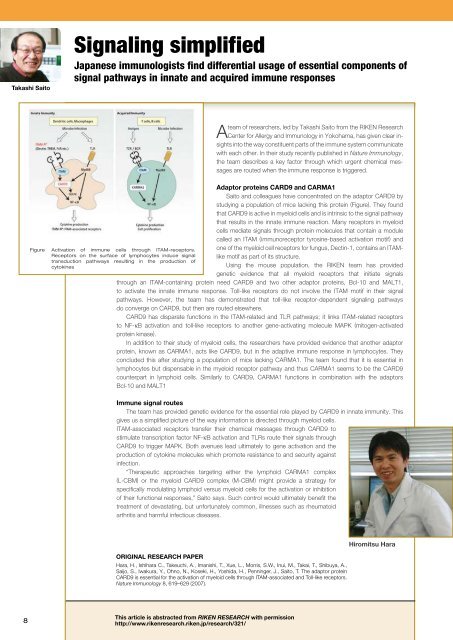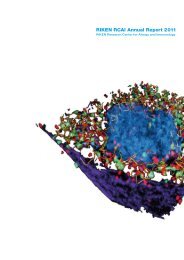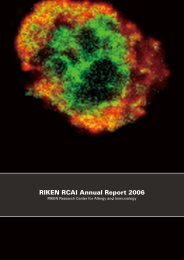in vivo
in vivo
in vivo
Create successful ePaper yourself
Turn your PDF publications into a flip-book with our unique Google optimized e-Paper software.
Takashi Saito<br />
Signal<strong>in</strong>g simplified<br />
Japanese immunologists f<strong>in</strong>d differential usage of essential components of<br />
signal pathways <strong>in</strong> <strong>in</strong>nate and acquired immune responses<br />
team of researchers, led by Takashi Saito from the RIKEN Research<br />
A Center for Allergy and Immunology <strong>in</strong> Yokohama, has given clear <strong>in</strong>sights<br />
<strong>in</strong>to the way constituent parts of the immune system communicate<br />
with each other. In their study recently published <strong>in</strong> Nature Immunology,<br />
the team describes a key factor through which urgent chemical messages<br />
are routed when the immune response is triggered.<br />
Figure Activation of immune cells through ITAM-receptors.<br />
Receptors on the surface of lymphocytes <strong>in</strong>duce signal<br />
transduction pathways result<strong>in</strong>g <strong>in</strong> the production of<br />
cytok<strong>in</strong>es<br />
Adaptor prote<strong>in</strong>s CARD9 and CARMA1<br />
Saito and colleagues have concentrated on the adaptor CARD9 by<br />
study<strong>in</strong>g a population of mice lack<strong>in</strong>g this prote<strong>in</strong> (Figure). They found<br />
that CARD9 is active <strong>in</strong> myeloid cells and is <strong>in</strong>tr<strong>in</strong>sic to the signal pathway<br />
that results <strong>in</strong> the <strong>in</strong>nate immune reaction. Many receptors <strong>in</strong> myeloid<br />
cells mediate signals through prote<strong>in</strong> molecules that conta<strong>in</strong> a module<br />
called an ITAM (immunoreceptor tyros<strong>in</strong>e-based activation motif) and<br />
one of the myeloid cell receptors for fungus, Dect<strong>in</strong>-1, conta<strong>in</strong>s an ITAMlike<br />
motif as part of its structure.<br />
Us<strong>in</strong>g the mouse population, the RIKEN team has provided<br />
genetic evidence that all myeloid receptors that <strong>in</strong>itiate signals<br />
through an ITAM-conta<strong>in</strong><strong>in</strong>g prote<strong>in</strong> need CARD9 and two other adaptor prote<strong>in</strong>s, Bcl-10 and MALT1,<br />
to activate the <strong>in</strong>nate immune response. Toll-like receptors do not <strong>in</strong>volve the ITAM motif <strong>in</strong> their signal<br />
pathways. However, the team has demonstrated that toll-like receptor-dependent signal<strong>in</strong>g pathways<br />
do converge on CARD9, but then are routed elsewhere.<br />
CARD9 has disparate functions <strong>in</strong> the ITAM-related and TLR pathways; it l<strong>in</strong>ks ITAM-related receptors<br />
to NF-κB activation and toll-like receptors to another gene-activat<strong>in</strong>g molecule MAPK (mitogen-activated<br />
prote<strong>in</strong> k<strong>in</strong>ase).<br />
In addition to their study of myeloid cells, the researchers have provided evidence that another adaptor<br />
prote<strong>in</strong>, known as CARMA1, acts like CARD9, but <strong>in</strong> the adaptive immune response <strong>in</strong> lymphocytes. They<br />
concluded this after study<strong>in</strong>g a population of mice lack<strong>in</strong>g CARMA1. The team found that it is essential <strong>in</strong><br />
lymphocytes but dispensable <strong>in</strong> the myeloid receptor pathway and thus CARMA1 seems to be the CARD9<br />
counterpart <strong>in</strong> lymphoid cells. Similarly to CARD9, CARMA1 functions <strong>in</strong> comb<strong>in</strong>ation with the adaptors<br />
Bcl-10 and MALT1<br />
Immune signal routes<br />
The team has provided genetic evidence for the essential role played by CARD9 <strong>in</strong> <strong>in</strong>nate immunity. This<br />
gives us a simplified picture of the way <strong>in</strong>formation is directed through myeloid cells.<br />
ITAM-associated receptors transfer their chemical messages through CARD9 to<br />
stimulate transcription factor NF-κB activation and TLRs route their signals through<br />
CARD9 to trigger MAPK. Both avenues lead ultimately to gene activation and the<br />
production of cytok<strong>in</strong>e molecules which promote resistance to and security aga<strong>in</strong>st<br />
<strong>in</strong>fection.<br />
“Therapeutic approaches target<strong>in</strong>g either the lymphoid CARMA1 complex<br />
(L-CBM) or the myeloid CARD9 complex (M-CBM) might provide a strategy for<br />
specifically modulat<strong>in</strong>g lymphoid versus myeloid cells for the activation or <strong>in</strong>hibition<br />
of their functional responses,” Saito says. Such control would ultimately benefit the<br />
treatment of devastat<strong>in</strong>g, but unfortunately common, illnesses such as rheumatoid<br />
arthritis and harmful <strong>in</strong>fectious diseases.<br />
ORIGINAL RESEARCH PAPER<br />
Hara, H., Ishihara C., Takeuchi, A., Imanishi, T., Xue, L., Morris, S.W., Inui, M., Takai, T., Shibuya, A.,<br />
Saijo, S., Iwakura, Y., Ohno, N., Koseki, H., Yoshida, H., Penn<strong>in</strong>ger, J., Saito, T. The adaptor prote<strong>in</strong><br />
CARD9 is essential for the activation of myeloid cells through ITAM-associated and Toll-like receptors.<br />
Nature Immunology 8, 619–629 (2007).<br />
Hiromitsu Hara<br />
8<br />
This article is abstracted from RIKEN RESEARCH with permission<br />
http://www.rikenresearch.riken.jp/research/321/





